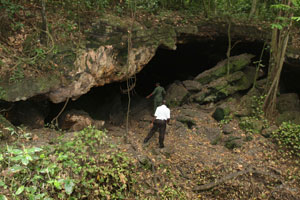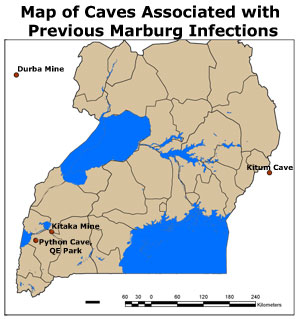Imported Marburg Hemorrhagic Fever: One That Got Away
Posted January 30, 2009 by Ali S. Khan

CDC’s Special Pathogens Branch recently diagnosed a case of Marburg hemorrhagic fever in a U.S. traveler, who returned from Uganda back in January 2008 [SPB posting]. This person had visited the famous “python cave” in Maramagambo Forest, Queen Elizabeth Park, western Uganda. Fortunately, no one seems to have been infected from this patient when she was hospitalized. But we are never more than 24 hours away from the next new infectious disease.
According to Dr. Pierre Rollin, CDC’s chief expert in viral hemorrhagic fevers, the patient developed illness 4 days after returning to the United States, was hospitalized, and fully recovered. The original testing of samples collected during the patient’s illness in January 2008 did not show clear evidence of Marburg virus infection. Testing of a later sample has also shown equivocal results for previous infection, so more detailed testing of both samples was conducted and it was confirmed that the patient’s illness was due to Marburg hemorrhagic fever virus.

The “python cave” is a popular destination among tourists to see the bat-infested cave. A Dutch tourist who had entered this same cave died of Marburg hemorrhagic fever in July 2008. This prompted the Ugandan Ministry of Health to officially request the cave be closed last August and that the Uganda Wildlife Authority guides no longer schedule nature walks in the cave. Both patients likely acquired their infections as a result of contact with cave-dwelling fruit bats, which are capable of harboring Marburg virus. The Kitaka mine in Kamwenge, which was the source of a Marburg outbreak in Uganda in 2008, is approximately 60-75 Km from the python cave in Maramagambo. These sites are under active investigation by our Special Pathogens Branch and a newly established International Collaborative on Infectious Disease Ecologies Center [ICIDE] in Uganda. Interestingly, our team found a band in the “python cave” that fell off from a bat that had been banded in the Kitaka mine, demonstrating bat movements between roosting sites. We still need to investigate many aspects of the ecology of hemorrhagic fever viruses in wildlife, including in bats, to better understand the transmission dynamics of these viruses in animals and humans.
Comments
No comments posted.
Disclaimer: The content of Public Health Matters expresses the opinions of its authors and does not necessarily represent the views of the Centers for Disease Control and Prevention.
- Page last reviewed: January 30, 2009
- Page last updated: February 2, 2009
- Content source: National Center for Zoonotic, Vector-Borne, and Enteric Diseases
Get email updates
To receive email updates about this page, enter your email address:
Contact Us:
- Centers for Disease Control and Prevention
1600 Clifton Rd
Atlanta, GA 30333 - 800-CDC-INFO
(800-232-4636)
TTY: (888) 232-6348
24 Hours/Every Day - cdcinfo@cdc.gov


